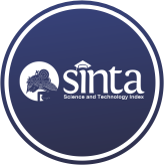Penilaian Manajemen Risiko Menggunakan Octave Allegro Pada Data Center Perguruan Tinggi
(1) Universitas Terbuka, Indonesia
(*) Corresponding Author
Abstract
Full Text:
PDFReferences
I. M. M. Matin, A. Arini, and L. K. Wardhani, “Analisis Keamanan Informasi Data Center Menggunakan Cobit 5,” J. Tek. Inform., vol. 10, no. 2, pp. 119–128, 2018, doi: 10.15408/jti.v10i2.7026.
B. Rahardjo, Keamanan Perangkat Lunak. PT Insan Infonesia, 2016.
O. Arifudin, U. Wahrudin, and F. D. Rusmana, MANAJEMEN RISIKO. Widina, 2020.
D. M. Alghazzawi, S. H. Hasan, and M. S. Trigui, “Information Systems Threats and Vulnerabilities,” Int. J. Comput. Appl., vol. 89, pp. 25–29, 2014.
M. E. Whitman and H. J. Mattord, “Management of information security,” Cengage Learn., 2013.
Syafrinal and Agusrijar, “Audit Keamanan Sistem Informasi Pada Data Center Menggunakan Standar SNI-ISO 27001,” Audit Keamanan Sist. Inf. Pada Data Cent. Menggunakan Standar SNI-ISO, vol. 4, no. September, p. 581, 2020.
F. Nafisah, W. Putra, and A. Herlambang, “Evaluasi Keamanan Informasi Data Center Berdasarkan Standar ISO 27001:2013 (Studi Kasus PT. Pupuk Kalimantan Timur),” J. Pengemb. Teknol. Inf. dan Ilmu Komput., vol. 4, no. 6, pp. 1858–1865, 2020, [Online]. Available: https://j-ptiik.ub.ac.id/index.php/j-ptiik/article/view/7441.
N. Tariq et al., “The security of big data in fog-enabled iot applications including blockchain: A survey,” Sensors (Switzerland), vol. 19, no. 8, pp. 1–33, 2019, doi: 10.3390/s19081788.
D. Achmadi, Y. Suryanto, and K. Ramli, “On Developing Information Security Management System (ISMS) Framework for ISO 27001-based Data Center,” Inst. Electr. Electron. Eng., 2018, doi: 10.1109/IWBIS.2018.8471700.
J. S. Suroso and B. Rahaldi, “Risk is the possibility of loss or damage caused by an act. Risk must be managed properly and thoroughly structured.,” ACM Int. Conf. Proceeding Ser., vol. Part F1306, no. Implementation In IT Governance For Support Business Strategy, pp. 92–96, 2017.
C. Alberts and A. Dorofee, Introduction to the OCTAVE Approach, no. August. Pittsburgh, PA 15213-3890: Carnegie Mellon University, 2003.
C. Woody, Applying OCTAVE: Practitioners Report. Carnegie Mellon University, 2006.
R. A. Caralli, J. F. Stevens, L. R. Young, and W. R. Wilson, “Introducing OCTAVE Allegro : Improving the Information Security Risk Assessment Process,” Young, no. May, pp. 1–113, 2007.
DOI: https://doi.org/10.30645/kesatria.v5i2.350
DOI (PDF): https://doi.org/10.30645/kesatria.v5i2.350.g347
Refbacks
- There are currently no refbacks.
Published Papers Indexed/Abstracted By:














